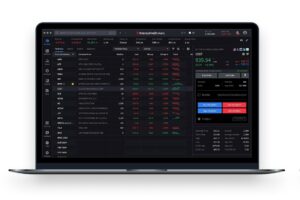At the end of Tuesday, the Dow Jones Index (US30) fell by 0.36%. The S&P 500 Index (US500) was up 0.16%. The NASDAQ Technology Index (US100) closed higher by 0.98%.
The latest data from the JOLTs report showed that job openings are at their lowest level since January 2021, along with increased layoffs. In contrast, the Central Bank’s Consumer Confidence Index rose sharply, posting its highest increase since March 2021. Despite the mixed signals, the dollar remained near its highest levels in three months, helped by expectations that the Fed will take a more cautious approach to its easing strategy. In addition, speculation surrounding Donald Trump’s possible victory in the November 5 election lent further support to the currency as his policies on tariffs, taxes and immigration are perceived to be inflationary.
In after-hours trading, shares of Alphabet (GOOG) were up nearly 6% following impressive quarterly revenue growth in its cloud division. Snap (SNAP) and Reddit were also up significantly, climbing 10.6% and 24.8%, respectively, thanks to strong quarterly results. AMD (AMD), however, suffered a downturn, falling 7.6% after posting weak fourth-quarter earnings guidance.
Equity markets in Europe were steadily declining on Tuesday. Germany’s DAX (DE40) fell by 0.27%, France’s CAC 40 (FR40) closed down 0.61%, Spain’s IBEX 35 (ES35) lost 0.91%, and the UK’s FTSE 100 (UK100) closed down 0.80%. European stock markets were set for declines on Wednesday as investors prepared for the latest GDP and inflation data from the region, as well as the UK government’s budget announcement. It is also a busy day for corporate earnings as reports from such large companies are scheduled. Notable earnings news included Swiss lender UBS reporting a third-quarter profit of $1.43 billion, well above estimates of $667.5 million, thanks to the successful integration of clients from Credit Suisse. UK-based Standard Chartered also reported earnings that exceeded projections and raised its revenue outlook for 2024.
WTI crude prices rose to around $67.5 a barrel on Wednesday after two consecutive declines, helped by an unexpected drop in US inventories. API data showed that US crude inventories fell by 0.6 million barrels last week, contradicting expectations of a 2.3 million barrel increase. Nevertheless, the downward trend persists as investor attention has shifted to weak fundamentals, including weak Chinese demand and ample supply, while traders await December OPEC+ production plans.
Silver (XAG/USD) rose to $34 an ounce on Tuesday, following gains in gold prices as uncertainty surrounding the US presidential election and tensions in the Middle East continue to drive demand for precious metals.
Asian markets were mostly rising on Monday. Japan’s Nikkei 225 (JP225) rose by 0.77%, China’s FTSE China A50 (CHA50) fell by 0.78%, Hong Kong’s Hang Seng (HK50) gained 0.49% and Australia’s ASX 200 (AU200) was positive 0.34%.
The offshore yuan fell to around 7.15 per dollar as traders are cautious ahead of the expected China PMI data to be released tomorrow. The data is expected to shed light on the impact of the latest stimulus measures. In addition, traders await the National People’s Congress meeting scheduled for November 4–8 for more details on the anticipated fiscal support measures.
In Australia, annual inflation fell to 2.8% in the third quarter, down from 3.8% in the previous quarter and slightly below the expected 2.9%. This marked the first time inflation has returned to the Reserve Bank of Australia’s (RBA) target range of 2–3% since the end of 2021. Core inflation, which is closely monitored by the Reserve Bank, also fell to 3.5% from 4%, which was in line with expectations. The latest inflation data suggests that price pressures in the country are easing, giving the Central Bank an opportunity to consider a rate cut at one of its last meetings of the year.









